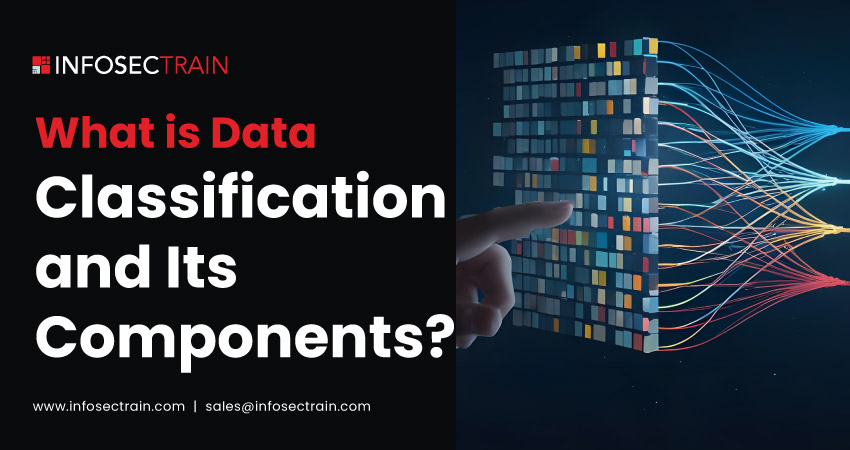What is Data Classification and Its Components?

What is Data Classification?
Data classification is the process of sorting and organizing data, whether it’s structured like databases or unstructured like emails, into categories based on how sensitive it is. The process helps organizations manage data securely by determining which information requires more stringent security measures, such as encryption, access controls, or restricted sharing, to prevent unauthorized access, disclosure, or misuse. By categorizing data, organizations can focus more on securing and managing sensitive data or information and complying with regulations.
Common data sensitivity levels include:
- Public: Data that is freely shareable with anyone without any concerns, such as marketing materials, press releases, company brochures, or public announcements.
- Internal/Private: Data that is used for internal purposes within an organization but considered low risk if exposed, like internal memos, meeting notes, employee guidelines, and standard operating procedures.
- Confidential: Sensitive data that, if disclosed, could harm the organization or individuals, such as employee records, business strategies, intellectual property, etc.
- Restricted/Highly Confidential: The most sensitive data that requires the highest security level, such as trade secrets, financial records, Personal Health Information (PHI), etc.
- Top Secret/Highly Restricted: The most sensitive information that could lead to serious harm to national security or the organization if disclosed, such as military operations, government intelligence, and highly sensitive business strategies.
Key Components of Data Classification
1. Data Ownership: This specifies who is accountable for specific data within the organization. The Data Owner is responsible for determining how data should be classified based on sensitivity and business value. This includes:
- Data Dictionary: A centralized repository that defines an organization’s structure, format, and meaning of data elements.
- Data Owner: The person or entity responsible for safeguarding and managing data, determining its classification, and controlling access to it.
- Data Custodian: The person or team responsible for the secure storage and transport of data, following the data owner’s classification and handling guidelines.
2. Data Labeling: The process of marking data based on its sensitivity and potential impact if compromised. It is essential for understanding how to protect and handle data. This includes:
- Sensitivity: Identifying the level of protection needed (e.g., public, internal, confidential, highly confidential).
- Impact: Assessing the consequences of data exposure or loss.
3. Data Types: This refers to the different types of data that need to be classified and managed. This includes:
- Structured Data: Data that is managed in a predefined format (e.g., databases, spreadsheets).
- Unstructured Data: Data that lacks a specific structure (e.g., emails, documents, multimedia files).
- Semi-structured Data: A hybrid form with some organizational elements, like tags, but not fully structured (e.g., JSON, XML, NoSQL databases).
- Quasi-structured Data: Data with irregular formatting but partial structure (e.g., weblogs, sensor data, email messages, clickstream data).
4. Data Handling: This refers to the specific practices or guidelines for handling data types based on the category. This includes:
- Personally Identifiable Information (PII): Data that can identify an individual, requiring strict handling and protection.
- Publicly Available Information: Data that can be freely accessed and does not require special protection.
5. Data Lifecycle: This means data undergoes various phases, from creation to destruction, requiring different levels of protection at each phase:
- Generation: Creation or collection of data.
- Storage: Where and how data is kept.
- Use: How data is accessed, processed, and utilized for business operations.
- Share: How data is distributed or shared with authorized parties or systems.
- Retention/Archive: How long data is maintained based on legal, regulatory, or business requirements.
- Destruction: Proper destruction or deletion of data when it is no longer needed.
Benefits of Data Classification
Data classification is important for organizations to manage and protect information effectively. Here are the key benefits of data classification:
1. Enhanced Security
- Ensures sensitive data is identified and protected with stringent security measures, including access controls and encryption.
- Reduces the data breaches, unauthorized access, and data leak risks.
2. Risk Mitigation
- Identifies and highlights sensitive data that could cause significant harm if mishandled or exposed.
- Prioritizes security efforts and resources to defend high-risk data, reducing overall risk exposure.
3. Regulatory Compliance
- Ensures data is categorized and handled in compliance with relevant standards to meet legal and regulatory requirements such as GDPR, HIPAA, etc.
- Minimizes the risk of legal penalties associated with non-compliance.
4. Cost Reduction
- Avoids over-investing in security for low-risk data by focusing resources on protecting high-risk information.
- Saves on data storage and management costs by classifying and disposing of data that is no longer needed.
5. Improved Data Management
- Allows for more organized storage and retrieval of data based on its classification.
- Reduces storage costs by properly managing and archiving data according to its importance.
CSSLP Certification Training with InfosecTrain
Enroll in InfosecTrain‘s CSSLP Certification Training course, which covers fundamental secure software development concepts, including data classification. The course is led by experienced instructors who provide insights into best practices for data classification and equip participants to understand how to categorize data based on sensitivity, criticality, and regulatory requirements.







 1800-843-7890 (India)
1800-843-7890 (India)